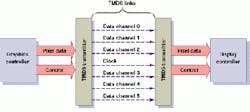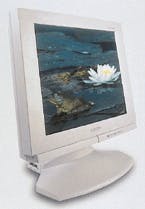Product Focus: Digital standards for flat-panel monitors ease integration task
Common digital interface for flat-panel-display and CRT monitors will lower the cost and complexity of analog and digital connectivity.
By Andrew Wilson,Editor at Large
Before the advent of flat panels, many displays used in imaging systems were based on cathode-ray-tube (CRT) analog technology. Accordingly, digital data had to be converted into analog format to drive analog monitors. To accomplish this task, frame grabbers and display controllers incorporated high-speed digital-to-analog converters (DACs) to drive monitors to resolutions of 2k x 2k and higher. The Video Electronic Standards Association (VESA; Milpitas, CA) developed a number of standards, including video graphics adapter (VGA), extended graphics adapter (XGA), super extended graphics adapter (SXGA), and quality extended graphics adapter (QXGA), to support resolutions from 640 x 480 to 2048 x 1536 pixels and higher.
FIGURE 1. Using a transition-minimized differential-signaling interface, the digital-flat-panel (DFP) standard transmits video digitally to the monitor using four differential pairs—three data and one clock. Building a digital interface between the CPU and monitor using the DFP standard requires the use of transmitters (at the PC end) and a receiver (at the monitor).
With the introduction of flat-panel displays (FPDs), however, the need to convert digital image data to analog form for transmission to the display becomes redundant because the display only requires a digital input. To accommodate this situation, digital standards are under development by VESA. Unfortunately, such standards must also allow developers to migrate from their legacy CRT analog displays to digital types.
Rocky road
But the road to developing an industry-acceptable digital standard has been bumpy, with at least three working groups or consortiums in the United States, and others in Japan, all working on different digital interface standards. This standards development has been fractious, however.
Cost, of course, is the reason why developing a standard digital interface for both FPDs and CRT monitors has been so difficult (see "A brief history of acronyms and consortiums"). Originally, FPD developers used low-voltage-differential-signaling (LVDS) integrated circuits (ICs) to drive flat-panel displays. Seeing quality display improvements, Silicon Image (SiI; Cupertino, CA) was formed to develop a range of transmitter and receiver devices, originally known as PanelLink technology. Using these devices, FPD developers found that they could more easily configure digital central processor units (CPUs) to flat-panel displays.
Using this design, VESA introduced its now all-but-abandoned Plug and Display (P&D) interface. Based on PanelLink technology, the P&D specifications proved too costly and complex to incorporate. "Many in the industry felt that P&D was a good start for a digital specification, but it was also too expensive to implement, and it wasn't scalable for the future," says Phil Parker, director of marketing communications at Number Nine Visual Technology (NNVT; Lexington, MA), "When proposed, it supported analog, digital, Universal Serial Bus (USB), and IEEE-1394 (FireWire) standards," he adds. Needless to say, the P&D interface realized limited success in the field. At the time, however, VESA assumed that the existence of a digital flat-panel interface, along with a VGA connector, would allow OEMs to market flat-panel-enabled systems while maintaining VGA analog functionality for legacy monitors.
Seeing this limitation, Intel Corp. (Santa Clara, CA) and other interested companies formed the Digital Display Working Group (DDWG; Hillsboro, OR; www.ddwg.org) to develop the digital visual interface (DVI) standard based on transition- minimized differential signaling (TMDS). The group's aim, as Joshua Larson-Mogul, formerly of SGI (Mountain View, CA), explains, is to create a common digital interface specification that is scalable for the future, while at the same time supports legacy standards. "If the value of a flat-panel monitor lies in its lack of flicker, better image quality, and more compact form, customers are only likely to spend the additional money that FPDs cost if image quality is a priority," says Larson-Mogul.
Plug and display
Based largely on VESA's Plug and Display standard, the VESA-endorsed digital-flat-panel (DFP) standard led by Compaq Computer (Dallas, TX) allows a host computer to connect directly to an external digital flat-panel monitor over several meters of cable without the need for analog-to-digital converters. This interface method makes use of existing VESA standards to allow its implementation as an industry standard. It includes graphics-controller-interface functions to support digital video data, configuration management, and power management. As the standard embraces only the components necessary for digital-display-monitor functions, this interface enables a simple implementation in both host and monitor.
FIGURE 2. The OpenLDI standard specifies the serializing of parallel pixel data and sending it from the display source to the display device where the pixels are converted again to parallel format. Input signals to the OpenLDI transmitter at the display source include pixel data, horizontal and vertical sync, a data enable control, pixel clock, and two control signals. These signals are serialized and transmitted over LVDS differential pairs to the display device where the LVDS signals are received, converted to parallel format, and sent out from the OpenLDI receiver.
The DFP standard uses the TMDS interface developed by Silicon Image. This interface transmits the video digitally to the monitor using four differential pair signals (see Fig. 1). Building a digital interface between the CPU and the monitor using the DFP standard requires incorporation of transmitters (at the PC end) and a receiver (at the monitor).
Despite being used by a number of vendors, the DFP standard could only support resolutions to 1280 x 1024 pixels. This resolution was not high enough for companies such as SGI. "As resolutions of flat panels extend from 1280 x 1024 pixels to 1600 x 1200 pixels, liquid-crystal displays (LCDs) will gradually displace CRTs in many applications," says Larson-Mogul. "Unfortunately," he adds, " these higher resolutions cannot avoid the pixel clock errors inherent in the analog signal and could never have the image quality demanded by markets that require large resolutions and excellent image quality."
Higher resolutions
Although the Plug and Display standard continues to be supported by VESA, it requires a more expensive connector than other standards. Whereas the DFP standard is expedient, it has the downside of not supporting resolutions beyond XGA today or higher than SXGA in the near future. On the other hand, yet another standard, OpenLDI, while not endorsed by VESA, provides compatibility between flat-panel monitors and existing notebook computers, multisource availability, and single/ dual-channel flexibility. It also supports resolutions that DFP and Plug and Display cannot currently, and may not in the future, handle.
Drawing on the work standards developed by VESA and the American National Standards Institute, the OpenLDI standard describes a logical, electrical, and mechanical interface between a display source and a display device for the transfer of digital display data (see www.national.com/ appinfo/lvds/openldi.pdf). Included in this interface are communication channels for display identification (DDC/CI and EDID) and connection of peripheral devices (USB).
Like the DFP standard, OpenLDI allows digital display data to be transferred between a display source and a display device, avoiding the conversion of the display data into analog format with its resultant loss of information. Additionally, the specification describes a signaling mechanism that minimizes the number of wires needed to connect the display source to the display device and that minimizes electromagnetic interference (EMI).
In operation, the OpenLDI standard serializes the parallel pixel data and sends the information from the display source to the display device, where the pixels are converted again to parallel format (see Fig. 2). Input signals to the OpenLDI transmitter at the display source include pixel data, horizontal and vertical sync, data enable control, pixel clock, and two control signals. These signals are serialized and transmitted over LVDS differential pairs to the display device, where the LVDS signals are received, converted to parallel format, and sent out from the OpenLDI receiver.
FIGURE 3. First to embrace the OpenLDI standard in a product, the SGI 1600SW 1920 1080-pixel (HDTV) flat-panel monitor operates with the IV-FP graphics accelerator board from NNVT. Supporting resolutions from 640 x 480 to 1600 x 1024 pixels, the flat-panel display uses the OpenLDI interface to display digital images from the NNVT display controller.
First to embrace the OpenLDI standard in a product, SGI is offering a digital flat-panel bundle that combines its 1600SW flat-panel monitor with the Revolution IV-FP graphics accelerator board from Number Nine Visual Technology (see Fig. 3). In operation, the board and monitor combination enables the simultaneous display of two 8.5 x 11-in. pages. Supporting resolutions from 640 x 480 up to 1600 x 1024 pixels, the combination uses the OpenLDI interface to display digital images from the NNVT display controller. Powered by the Revolution IV-FP and the 128-bit 2-D and 3-D video accelerator from NNVT, the video controller card supports either AGP or PCI configurations and includes 32 Mbytes of local frame buffer and texture memory.
This is DVI
Recognizing the limitations of the P&D and DFP standards and the advantages of supporting higher resolutions, the DDWG recently introduced a DVI standard to support resolutions as high as 2500 x 2500 pixels. Similar to the DFP standard, the DVI standard relies on transmitters and receivers developed by Silicon Image to accomplish digital data transfer from graphics or frame-grabber cards to digital and analog flat-panel displays and CRTs (see Fig. 4).
During system operation, transmitters residing on the host take a digital stream from a graphics source, convert it to DVI-compliant digital output, and transmit that output to a receiver embedded in the display. The newest SiI 164 transmitter uses the company's digital technology to support displays from VGA to UXGA resolutions (25-165 Mpixel/s) in a single-link interface. This transmitter supports either a 12- or 24-bit mode for true color support. In 24-bit mode, the transmitter supports single- or dual-edge clocking. In 12-bit mode, it supports dual-edge single clocking or single-edge dual clocking. To ease systems design, an I2C slave interface simplifies programming by eliminating the requirement for external programming pins.
FIGURE 4. Using TMDS, the DVI allows two TMDS links, which enables large-pixel-format digital devices. Depending on the pixel format and timings desired, one or two TMDS links are available. The two links share the same clock, permitting the bandwidth to be evenly divided between the two links.
The SiI 161A receiver uses PanelLink digital technology to support displays ranging from VGA to UXGA (25-165 Mpixel/s) for LCD and digital CRT designs. This receiver supports up to 24 bits/pixel and, because the receiver's phase-lock loop uses only the frequency information and not the clock-edge location from the received clock signal, the receiver is immune to clock-to-data skew. In addition, receiver data output is time-staggered to reduce the ground bounce that affects EMI.
Already, several flat-panel vendors have incorporated SiI's PanelLink technology in their flat-panel designs, including Compaq Computer, IBM (Atlanta, GA), ViewSonic (Walnut, CA), and Princeton Graphics (Santa Ana, CA). Incorporated in the Compaq FP720 digital flat-panel monitor, SiI receivers allow up to 1024 x 768-pixel resolution images to be displayed on a 15-in. thin-film-transistor (TFT) active-matrix display.
FIGURE 5. Flat-panel display vendors incorporating PanelLink technology in their flat-panel designs include IBM (T85D 18.1-in. TFT monitor shown here), as well as Compaq Computer and Princeton Graphics.
Like Compaq, IBM has also used SiI receivers in the design of its T85D 18.1-in. TFT monitor. To drive the display, designers can use the company's AGP Plug and Display Digital Adapter with AGP or additional PCI cards under Windows 98/NT to support up to four monitors per CPU. Princeton Graphics also offers an 18.1-in. TFT LCD monitor, the DPP800. With a SXGA 1280 x 1024-pixel maximum resolution, TMDS digital interface, the monitor features a self-powered USB hub and a 230:1 contrast (see Fig. 5).
With the endorsement of the DVI standard by multiple monitor and display controller companies, the battle for a standard digital computer-to-monitor interface appears over. Intel and the DDWG have apparently won. Specifying an analog and a digital connector interface (in DVI-V) and a digital-only interface (in DVI-I), the standard supports both legacy and new digital controller and monitor designs. As display resolutions increase, the DVI specification is capable of transmitting data over six channels in a dual-link mode, therefore reducing the bandwidth on each link. Better still, the new standard also supports a feature known as DVI-CP, which will provide vendors of high-definition-television digital video disks (DVDs) copyright protection through intelligent encryption in both the disk player, graphics controller, and intelligent digital monitor.
ACKNOWLEDGMENT
The author thanks Phil Parker, director of marketing communications at Number Nine Visual Technology (Lexington, MA), for his help in preparing this article.
A brief history of acronyms and consortiums
•Low-voltage differential signaling (LVDS) was developed by IC vendors to drive laptop LCDs. The LVDS display standard is called low-voltage display interface (LVDI).
•PanelLink technology was developed by Silicon Image; it is the transition-minimized differential-signaling (TMDS) protocol.
•Video Electronic Standards Association (VESA) established Plug and Display (P&D) standard:
- Workgroup leader: VESA (www.vesa.org)
- Supports both analog and digital signals, with provisions for USB and IEEE-1394 (FireWire)
- P&D standard is too broad; many designers classify it as too expensive to implement
- Not widely adopted
- TMDS-based
- Maximum pixel clock: 165 MHz.
- Maximum resolution: 1280 x 1024 pixels (digital)
- Connector: P&D-D (30 pins)
- P&D-A/D (30 + 4 pins)
•Compaq forms digital-flat-panel (DFP) group; www.dfp-group.org:
- Established to create an inexpensive digital interface
- Uses Silicon Image ICs
- Workgroup leader: Compaq
- TMDS-based
- Low-cost, single-link, digital-only connector
- Maximum pixel clock: 165 MHz.
- Maximum resolution: 1280 x 1024 pixels
- Digital connector: MDR20 (20 pins)
- Currently widely supported
•National Semiconductor, AMP, Silicon Graphics, and others form Visual Interface Consortium (VIC) and OpenLDI standard:
- OpenLDI supports resolutions to 2048 x 1536 pixels.
- Dual link
- Supports digital only
•Intel sees need to establish a single, common display interface standard and forms the digital display working group (DDWG). It also sees limitations to P&D, DFP, and OpenLDI standards.
- Creates the digital visual interface (DVI)
- Major supporters: Intel, IBM, Compaq, Fujitsu, Hewlett-Packard, and NEC
- Backward compatible to P&D and DFP with adapter cable TMDS-based
- Maximum resolution: 2048 x 2048 pixels in dual-link mode
- Connectors: DVI-V, 24 pins, digital only
- DVI-I: 24 pins + 4 pins, integrated digital and analog
- DVI-CP: copyright-protection protocol
•Silicon Image PanelLink ICs produce transmitters and receivers to support DVI.
Company Information
Compaq Computer
Houston, TX 77269
(281) 370-0670
Fax: (281) 514-1740
Web: www.compaq.com/athome/ monitors/fp720/
Digital Display Working Group
Hillsboro, OR 97124
Fax: (503) 696-1213
Web: www.ddwg.org/
IBM
Atlanta, GA 30301
(888) 411-1WEB
Fax: (800) 2IBM-FAX
Web: www.pc.ibm.com/us/accessories/ access_promo/flatpanel/tour/index.html
Number Nine Visual Technology
Lexington, MA 02421
(781) 674-0009
Fax: (781) 869-7190
Web: www.nine.com/
Princeton Graphics
Santa Ana, CA 92704
(714) 751-8405
Fax: (714) 751-5736
Web: www.princetongraphics.com
SGI
Mountain View, CA 94043
(650) 960-1980
Web: www.sgi.com/
Silicon Image
Cupertino, CA 95014 USA
(408) 873-3111
Web: 206.251.29.113/
VESA
Milpitas, CA 95035
(408) 957-9270
Fax: (408) 957-9277
Web: www.vesa.org
ViewSonic
Walnut, CA 91789
(909) 869-7976
Web: www.viewsonic.com





